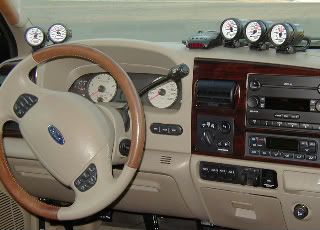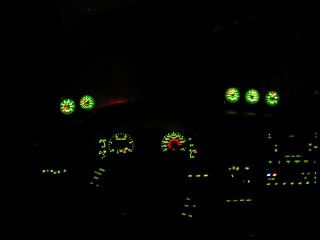Pressure Guages
#1
Pressure Guages
In the spread sheets there is a comment that states "DO NOT GET AUTOMETER GAUGES". Is there a reason for this? I would like to get a dual guage to read Fuel and Oil pressures. I've had Autometer guages on my gas truck and didn't have any problems with them.
I would like to install the blue spring kit but not sure if it has been installed already. It looks like it would be a good idea to monitor fuel pressure anyway. With an Oil pressure guage would it be better to monitor high or low pressures?
I would like to install the blue spring kit but not sure if it has been installed already. It looks like it would be a good idea to monitor fuel pressure anyway. With an Oil pressure guage would it be better to monitor high or low pressures?
#2
I'm not aware of any fitment or function issues with the Autometer gauges. The high pressure oil can be monitored through the OBDII port with a ScanGauge or similar. One of these OBD devices is definately the way to go if you want to monitor the engines vitals. I would do the low pressure gauge because it can't be monitored by an OBDII gauge.
Because the blue spring is intended to correct a problem with the old set up, it's not going to hurt anything even if your current pressure is ok.
Because the blue spring is intended to correct a problem with the old set up, it's not going to hurt anything even if your current pressure is ok.
#3
All my analog gauges are Autometer, so I have no idea what that would be on there. I would actually recommend Autometer compared to some of the other analog gauges that some people on this forum buy.
#4
#6
I have been using Autometer for 20 years with not one failure, in my race cars. I just put two in my F250 - fuel pressure and voltage. I chose the Elite series, they are what Nascar is using now and they have settable alarms for high and low thresholds, and you can program the colours. http://www.autometer.com/media_newsarticle.aspx?aid=106
If you are installing a fuel pressure gauge, get an electric one and remote mount the sending unit with one of these: 6.0L Fuel Pressure Adapter
It was a complete PITA making an adaptor that would fit for the sending unit directly mounted on the test port. I had to cut the one I got down on my lathe and cut new 16mm hex on it with the Bridgeport.
Brian
If you are installing a fuel pressure gauge, get an electric one and remote mount the sending unit with one of these: 6.0L Fuel Pressure Adapter
It was a complete PITA making an adaptor that would fit for the sending unit directly mounted on the test port. I had to cut the one I got down on my lathe and cut new 16mm hex on it with the Bridgeport.
Brian
#7
I have the scan guage II already, would the ICP readings be sufficient for the high oil pressure readings? I would like to buy the blue spring kit, just didn't want to buy it again if its already there. Just trying to save a few bucks, I figured I would put that money towards something else on the list.
Trending Topics
#8
Blue spring kit is $50, My truck had $5,000 worth of work because it wasn't there... I can do that math on the fingers of one hand, just sayin'... 

SGII is perfect for almost everything, except fuel pressure and low system oil pressure, EGT, since the computer doesn't have sensors for that.
Brian


SGII is perfect for almost everything, except fuel pressure and low system oil pressure, EGT, since the computer doesn't have sensors for that.
Brian
#10

#11
I have the scan guage II already, would the ICP readings be sufficient for the high oil pressure readings? I would like to buy the blue spring kit, just didn't want to buy it again if its already there. Just trying to save a few bucks, I figured I would put that money towards something else on the list.
I think you are getting the applications mixed up. ICP is Injection Control Pressure, and the fluid is crankcase motor oil. Yes, the Scangage does a good job of displaying ICP.
The blue spring is for the fuel pressure regulator. The fluid is diesel. The engine does not have a pressure sender for fuel pressure, and because the Scangage is not expandable, you cannot use it for fuel pressure.
If you don't know if the truck already has the blue spring, you can put a gauge in it to test the pressure. But that requires some disassembly about equal to the work required to install the new spring. And since you can get a spring kit for less than $40, I would personally just buy it and the electronic gauge and do it all at once. Otherwise, for $40, you risk installing the gauge, then finding low pressure, and taking it apart again to install the spring. It's only an hour job either way, but is still double the work.
#12
I think you are getting the applications mixed up. ICP is Injection Control Pressure, and the fluid is crankcase motor oil. Yes, the Scangage does a good job of displaying ICP.
The blue spring is for the fuel pressure regulator. The fluid is diesel. The engine does not have a pressure sender for fuel pressure, and because the Scangage is not expandable, you cannot use it for fuel pressure.
If you don't know if the truck already has the blue spring, you can put a gauge in it to test the pressure. But that requires some disassembly about equal to the work required to install the new spring. And since you can get a spring kit for less than $40, I would personally just buy it and the electronic gauge and do it all at once. Otherwise, for $40, you risk installing the gauge, then finding low pressure, and taking it apart again to install the spring. It's only an hour job either way, but is still double the work.
The blue spring is for the fuel pressure regulator. The fluid is diesel. The engine does not have a pressure sender for fuel pressure, and because the Scangage is not expandable, you cannot use it for fuel pressure.
If you don't know if the truck already has the blue spring, you can put a gauge in it to test the pressure. But that requires some disassembly about equal to the work required to install the new spring. And since you can get a spring kit for less than $40, I would personally just buy it and the electronic gauge and do it all at once. Otherwise, for $40, you risk installing the gauge, then finding low pressure, and taking it apart again to install the spring. It's only an hour job either way, but is still double the work.
I was thinking that the plug in the fuel filter housing was all that needed to be removed to install gauge? Ok well maybe doing too much thinking is getting me in trouble, still trying to figure this out.
#13
Low (crankcase) oil pressure is what the gauge on the dash is supposed to represent. The sender for the gauge is not variable like a volume **** on a radio which is how they normally work-instead on our truck it is a switch that is flipped at 7psi. That makes the gauge a "dummy light" and makes a low pressure oil gauge usefull.
High Pressure Oil is used to drive your injectors. Low pressure oil is pumped into a resivor on top of the engine where the High Pressure Oil Pump jacks the pressure up based on what the engine needs to operate the injectors (way over 3,000psi under some circumstances). So knowing HPO psi is a good way to monitor for leaks in the oil system to the injectors and troubleshoot starting and running issues. The pressure is changed by closing a valve in the IPR and monitored by the PCM using the ICP. This loop only affects the HPO system and isn't connected to the fuel delivery system pressure.
As you probably know the fuel pressure is generated by an electric pump under the truck and mechanically regulated using a spring in the upper fuel filter housing. There is no Electrical sensor to alow the pcm to monitor pressure in the fuel system, so if you want to monitor fuel pressure you will have to add a sensor and a gauge as it isn't possible to monitor fuel pressure with an OBD connected device.
So to monitor all of this you would have a low pressure oil gauge monitoring a sender you have installed, a high pressure oil gauge monitoring the ICP, and a fuel pressure gauge also monitoring a sender you have installed.
Hope that helps
High Pressure Oil is used to drive your injectors. Low pressure oil is pumped into a resivor on top of the engine where the High Pressure Oil Pump jacks the pressure up based on what the engine needs to operate the injectors (way over 3,000psi under some circumstances). So knowing HPO psi is a good way to monitor for leaks in the oil system to the injectors and troubleshoot starting and running issues. The pressure is changed by closing a valve in the IPR and monitored by the PCM using the ICP. This loop only affects the HPO system and isn't connected to the fuel delivery system pressure.
As you probably know the fuel pressure is generated by an electric pump under the truck and mechanically regulated using a spring in the upper fuel filter housing. There is no Electrical sensor to alow the pcm to monitor pressure in the fuel system, so if you want to monitor fuel pressure you will have to add a sensor and a gauge as it isn't possible to monitor fuel pressure with an OBD connected device.
So to monitor all of this you would have a low pressure oil gauge monitoring a sender you have installed, a high pressure oil gauge monitoring the ICP, and a fuel pressure gauge also monitoring a sender you have installed.
Hope that helps

#15
Thanks Rusty axlerod for the explanation, brings some things into perspective.
Bismic was just curious about the comment, being I had auto meter gauges before. There is a lot of useful info there, thanks for sharing.
So I guess I will get the blue spring kit and the fuel pressure gauge and and monitor low pressure if I can get a dual gauge for those readings. I'll just monitor the high pressure with the scan gauge at the ICP sensor.
Bismic was just curious about the comment, being I had auto meter gauges before. There is a lot of useful info there, thanks for sharing.
So I guess I will get the blue spring kit and the fuel pressure gauge and and monitor low pressure if I can get a dual gauge for those readings. I'll just monitor the high pressure with the scan gauge at the ICP sensor.






